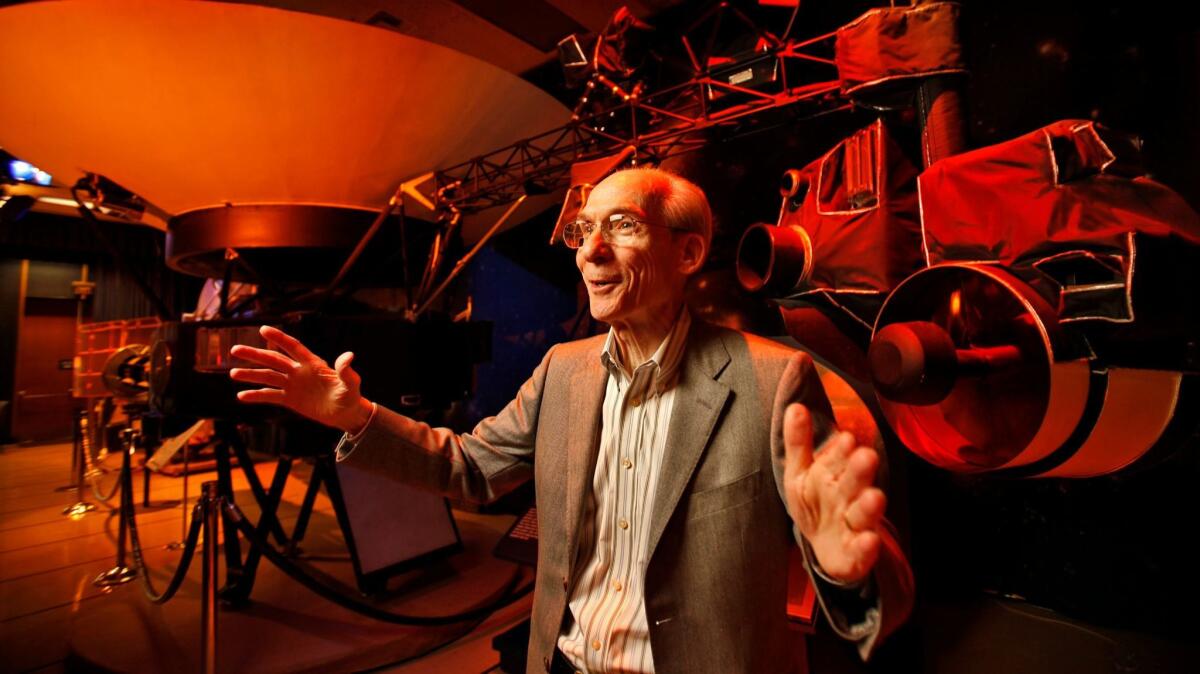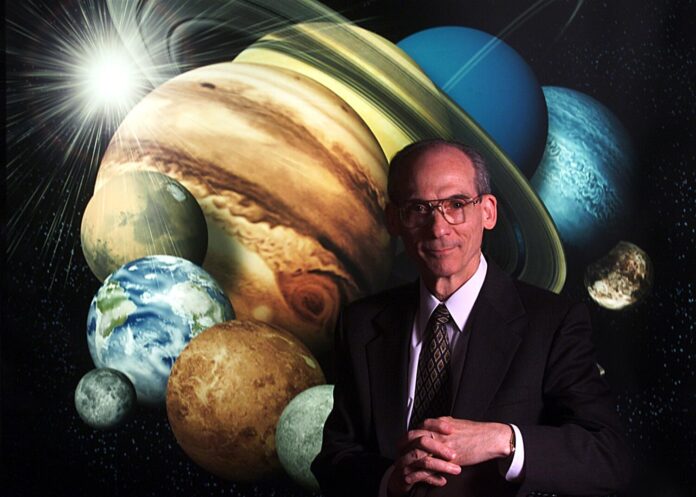Ed Stone, the scientist who guided NASA’s breakthrough Voyager mission to the outer planets for 50 years and led the Jet Propulsion Laboratory when it landed its first rover on Mars, died Tuesday. He was 88.
A physicist who bought in on the bottom flooring of area exploration, Stone performed a number one position in NASA missions to Mars, Jupiter, Saturn, Uranus and Neptune. The discoveries made below his watch revolutionized scientists’ understanding of the photo voltaic system and fueled humanity’s ambition to discover distant worlds.
Carolyn Porco, who labored on imaging on JPL’s Voyager and Cassini missions, known as Stone “a completely pretty man” who was “as near good as a venture scientist might ever be.”
“When two science groups have been in rivalry over some spacecraft useful resource, and Ed needed to resolve between the 2, even the man who misplaced went away considering, ‘Properly, if that is what Ed has determined, then it should be the fitting reply,’” Porco stated by e-mail Tuesday. “I really feel blessed to have recognized Ed. And like many individuals right this moment, I’m very unhappy to know he’s gone.”
Stone was a 36-year-old Caltech physics professor in 1972 when he was requested to function chief scientist for an audacious plan to ship a pair of spacecraft to discover the photo voltaic system’s 4 large planets for the primary time.
It was the chance of a lifetime, however he wasn’t positive he wished the gig.
“I hesitated as a result of I used to be a reasonably younger professor at that time. I nonetheless had quite a lot of analysis I wished to do,” he recalled 40 yr later.
He took it anyway, and from the mission’s first encounter with Jupiter in 1979 to its closing flyby of Neptune in 1989, Stone grew to become the scientific face of the Voyager mission. He guided the science agenda and helped the general public make sense of revolutionary photos and knowledge not simply from Jupiter, Saturn, Uranus and Neptune, however from lots of their fascinating moons.
Stone and his greater than 200 science collaborators have been the primary to find lightning on Jupiter and volcanoes on its moon Io. They noticed six never-before-seen moons round Saturn and located proof of the most important ocean within the photo voltaic system on Jupiter’s moon Europa, in addition to geysers on Neptune’s moon Triton.
“It appeared like all over the place we seemed, as we encountered these planets and their moons, we have been stunned,” Stone instructed the Los Angeles Occasions in 2011. “We have been discovering issues we by no means imagined, gaining a clearer understanding of the surroundings Earth was a part of. I can shut my eyes and nonetheless keep in mind each a part of it.”
The Voyager 1 spacecraft grew to become the first artifical object to achieve interstellar area in 2012, and Voyager 2 adopted go well with in 2018.

Stone, pictured with a mannequin of the Voyager spacecraft, stated the invention of volcanoes on Io was a spotlight of the mission.
(NASA)
The dual probes proceed to ship weekly communications to Earth from interstellar area. Stone retired in 2022 on the mission’s fiftieth anniversary.
“Part of Ed lives on within the two Voyager spacecraft. The fingerprints of his dedication and eager management are woven into the Voyager mission,” stated Linda Spilker, who joined the mission in 1977 and succeeded him as venture scientist.
The Voyager mission was Stone’s crowning achievement, however hardly his just one.
He was a principal investigator on 9 NASA missions and a co-investigator on 5 others, together with a number of satellites designed to check cosmic rays, the photo voltaic wind and the Earth’s magnetic area.
He grew to become director of the Jet Propulsion Laboratory in La Cañada Flintridge in 1991, a task he held for a decade.
It was an period of cost-cutting at NASA, however Stone nonetheless managed to launch Galileo’s five-year mission to Jupiter and ship the Cassini spacecraft to Saturn. He was additionally on the company’s helm when Mars Pathfinder delivered the Sojourner rover to the Purple Planet. It marked the primary time that people had put a robotic rover on the floor of one other planet.
All through his tenure at JPL, Stone continued to work and educate at Caltech, even educating freshman physics throughout a few of Voyager’s lengthy cruise instances between planets.
He additionally served as chairman of the board of the California Assn. for Analysis in Astronomy, which is liable for constructing and working the W.M. Keck Observatory and its two 10-meter telescopes on Mauna Kea, Hawaii.
Edward Carroll Stone Jr. was born in Iowa on Jan. 23, 1936, and grew up in Burlington, the place his father ran a small building enterprise and his mom saved the corporate books.
The eldest of two brothers, Stone was interested in science from a younger age. Below his father’s watchful eye, he discovered how one can take aside and reassemble all styles of expertise, from radios to vehicles.
“I used to be all the time excited about studying about why one thing is this manner and never that method,” Stone instructed an interviewer in 2018. “I wished to know and measure and observe.”
After learning physics at Burlington Junior Faculty, he acquired his grasp’s and doctorate on the College of Chicago. Shortly after he started his graduate research, information broke in 1957 that the previous Soviet Union had launched Sputnik, the world’s first synthetic satellite tv for pc.
“Identical to that, due to the Chilly Battle and our must match Sputnik, a complete new realm completely opened up,” he stated.
Stone constructed a tool for measuring the depth of photo voltaic energetic particles above the environment that hitched a journey to area aboard an Air Power satellite tv for pc in 1961. Sadly the spacecraft’s transmitter didn’t work, so solely a really restricted amount of information was returned to Earth. Nonetheless, it was nonetheless sufficient to point that the depth of the particles was decrease than anticipated.
Regardless of the transmitter glitch, Stone stated the venture was thrilling. “We have been taking the primary steps in a complete new space of analysis and exploration,” he stated. “We have been proper initially.”
He joined the college at Caltech in 1964 and created extra space experiments, this time for NASA.
Stone’s specific space of curiosity was cosmic rays — high-speed atomic nuclei that may originate from explosive occasions on the solar or from violent occasions past the photo voltaic system.
One in all his cosmic-ray experiments was included among the many 11 main Voyager experiments.

Ed Stone in 2011, a couple of yr earlier than Voyager 1 entered interstellar area.
(Al Seib / Los Angeles Occasions)
Colleagues praised Stone for his management of the Voyager science group.
“He was an amazing hero, a large amongst males,” stated Porco, including that Stone was recognized to deal with everybody — from high scientists to graduate college students — with respect.
Voyager group scientist Thomas Donahue put it this manner: “Through the years, Ed Stone has proved to be remarkably adept at preserving a bunch of prima donnas on monitor.”
Stone was elected to the Nationwide Academy of Sciences in 1984 and acquired the Nationwide Medal of Science from President George H.W. Bush in 1991 in recognition of his management of the Voyager mission. He gained the Shaw Prize in Astronomy in 2019, an honor that comes with a $1.2-million award. In 2012 his hometown of Burlington, Iowa, named its new center faculty after him.
“That is actually an honor as a result of it comes from the neighborhood the place my exploration journey started,” Stone instructed a neighborhood newspaper.
A long time after Voyager’s launch he was requested to pick out his favourite second from the mission. He selected the invention of volcanoes on Jupiter’s moon Io.
“Discovering a moon that’s 100 instances extra energetic volcanically than the complete Earth, it’s actually fairly hanging,” he stated. “And this was typical of what Voyager was going to do on the remainder of its journey by way of the outer photo voltaic system.
“Time after time, we discovered that nature was far more ingenious than our fashions,” he stated.
His spouse, Alice, whom he met on a blind date on the College of Chicago and married in 1962, died in December. The couple are survived by their two daughters, Susan and Janet Stone, and two grandsons.














